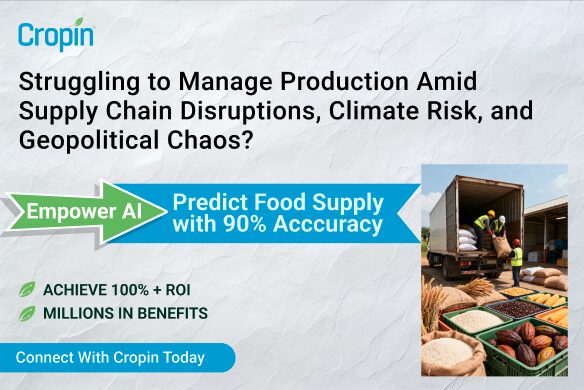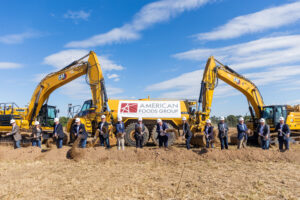Editor’s Note: The Thought Leaders in Agriculture series is presented by IntelinAir, makers of AgMRI: a digital decision support system for farmers using aerial imaging. The first in the series is a conversation with Robert Saik, founder of Agri-Trend, a digital agronomy business that was acquired by Trimble in 2015.
Agricultural futurist Robert Saik is a professional agronomist and certified agricultural consultant. He has published over 50 articles on crop agronomics and is a thought leader on the integration of technology in crop production.
Robert was awarded the 2014 Canadian Agri-Marketer of the Year by the Canadian Association of Agricultural Marketers.
He is the executive producer of KNOW IDEAS Media (Facebook / YouTube) which is dedicated to providing science-based education on the use of genetic engineering in agriculture.
Robert has founded over 15 companies ranging from field diagnostic and sensory technology firms, fertilizer manufacturing, fertilizer distribution, agri-retail, agricultural consulting and farming including a pure-bred cattle operation.
Imagine you are giving a “State of the Union” speech for agriculture. What are the main points you would make?
Regardless of what food “religion” you believe in – whether you’re vegan, paleo, organic, GMO, non-GMO or whatever denomination you come from – the one thing we all agree on is that agriculture must be infinitely sustainable. Otherwise, the human race doesn’t exist.
We must remember how fragile we are. The human race lives off six inches of topsoil that feeds all the plants and animals on the planet. Agriculture must adopt and utilize new sciences and technologies as they emerge.
As society has evolved, and people get more urban, fewer people are on the land actually growing the crops. There’s a divorce between what agriculture currently is and people’s perception. And perception is not reality.
Farmers today are very sophisticated, running multiple computers, data sets, doing amazing things with technology integration. The image of agriculture with a lot of urban consumers is still one of round-fendered pickup trucks, bib overalls, a straw hanging out of the mouth and a red barn. And that’s just not agriculture today.
Agriculture must be infinitely sustainable.
Otherwise the human race doesn’t exist.
Agriculture continues to evolve and continues to integrate new technology. Our ability to feed the planet is certainly there.
More people die of obesity than they do of starvation. We are at the lowest incidence of global poverty ever; less than 800 million people are living at the extreme poverty level, which is still a huge number, but much lower than a decade ago and a screaming success for agriculture.
If we implement the technologies at our disposal, we can vastly increase the quality of agricultural output and decrease our environmental footprint.
Let’s talk about data-driven agriculture. What technologies are the most promising in the near future?
First is field sensor technology. Whether it’s moisture sensors placed in the field, nutrient sensors placed in the field, leaf sensors to detect evapotranspiration rates – all of those things are interesting.
Then there’s aerial imaging and analytics for early-stage detection of problems.
For in-season data acquisition, you have drones, fixed-wing craft, microsatellites and macro satellites. As you go higher in the air the resolution decreases. High-resolution aerial imagery is really important. When we’re dealing with crops, we need to have a high-enough resolution that we can actually determine what we’re looking at. And we need to be alerted as to where in the field issues are cropping up. Timely information helps the farmer or agronomist pinpoint the precise location of a problem in the field.
Let me explain the scale of this problem.
We work with many farmers that have five, 10, fifteen, 30,000 acres. Hundreds of fields. Here’s the problem: how do you scan tens of thousands of acres and then – in a timely manner – determine which ones are being impacted by a nutrient deficiency, a biotic or an abiotic stress?
Can the farmer on a 15,000 or 30,000-acre farm scout that land detailed enough and fast enough to provide actions in real-time? The answer is self-evident.
But with aerial imagery and analytics, that’s one of the problems that I think we’re starting to crack.
One of the keys to making this technology work is the rapid acquisition of data. Fixed-wing aircraft can get large swaths of land frequently. That’s the first step.
How do you scan tens of thousands of acres and then – in a timely manner – determine which ones are being impacted?
Then, you have to ingest terabytes worth of data. That sheer amount of data used to be a significant issue, but increasing computing power makes us able to ingest all that data quickly.
Once you’ve got the images, you combine digital image analysis with artificial intelligence. Now – in very little time – you can perform anomaly detection and change detection. You can see the degree of completeness of the seeding rows. You can even do weed detection.
All of those things can be brought into a machine-learning type of algorithm. And ultimately, that can alert the farmer: “Hey! Of the hundred fields you have, these four fields have an alert right now. These certain parts of this field that should be scouted out immediately.”
And the software will point you exactly to those areas where you should go walk.
Why do you consider the disconnect between the perceptions of urban consumers and the reality of agricultural producers so important?
Because concentrations of population in urban centers understand less and less about agriculture. Activist groups combine that ignorance and then leverage social media to create absolute hysteria around things that are non-issues.
They use fear to generate membership sales and to propagate panic in urban consumers. That ultimately leads to poor policy implemented by politicians, which ultimately strips tools out of farmers hands.
You have a population, an urban population that can vote to tear the tools and the technology away from agriculture’s hands. And I don’t have to go very far to give you examples. GMO is a breeding technique. And CRISPR technology is more precise than traditional breeding techniques.
The more science you understand, the more you understand the science of genetic engineering, the more you would regard GMO as a remarkable advancement of the breeding process.
And yet that’s not what the average consumer is being led to believe.
Please comment about the recent decision out of the EU that limited the use of CRISPR technology?
It’s absurd. It’s an ill-formed, ill-conceived decision that basically grounds European agriculture in 2001-era technology.
I’ve read the ruling. The ruling basically said that CRISPR technology is deemed “the same as GMO technology.” They equated the precise editing of genes in an organism to “transgenic,” which is moving genes back and forth between organisms.
According to the ruling, if you expose seeds to mutagenesis – which is chemo or nuclear mutation – that’s okay. As long as you mutated the crops before 2001. That’s “old” mutagenesis or “old” mutation. But if you mutate crops using those methods today, that’s “new” mutagenesis.
The more science you understand, you would regard GMO as a remarkable advancement of the breeding process.
So what they basically said is this: the random scrambling of chromosomes underneath the archaic science that we had in 2001 is perfectly fine. But when you specifically edit one or two genes to prevent a disease or a fungus or fight some sort of a pest problem, that’s deemed as a “genetic interference.”
And so it falls underneath the Precautionary Principle which basically says, you have to prove things are not harmful to the environment and not harmful to human beings. That’s impossible to do. You can’t prove a negative.
So the Precautionary Principle will stymie all development of breeding in the European Union.
What are some of the second-order effects of the ruling?
Those scientists working on CRISPR technology, gene editing, genetic engineering, will be leaving the EU. They have no incentive to work on that technology in a jurisdiction where you can’t commercialize it.
The EU will become the “Museum of Agriculture.” It’s unfortunate for them, but it’ll create opportunities for those jurisdictions around the world that can adopt a new technology.
I fear that this European Union ruling on CRISPR will also condemn many African nations to perpetual darkness in terms of agricultural science because a lot of African nations take their lead from EU policy.
What are the effects on the market as a result of this EU decision? How can those outside of the EU take advantage of this situation? What are the natural advantages that are going to accrue because of this situation?
There are some opportunities.
The USDA has already determined that CRISPR technology is not the same as transgenics. So it’s going to give those of us that adopt this new technology a leg up.
Germany is suffering a drought right now. If you had access to science, you’d be able to breed crops that are more drought tolerant.
What opportunities are going to open up for other technologies in the EU? What I’m thinking is – because we’ve got crops that don’t have the opportunity to be genetically modified, to be resistant to pests or various organic disease processes – it would seem that scientists who create technologies to help get an early warning for those kinds of things will have a bigger opportunity.
If you were in the EU right now, and you’re looking at your options for herbicide control, one option is tillage, which is not good for the soil and also not good for greenhouse gas balance.
The EU will become the “Museum of Agriculture.”
However, if you can’t use herbicide-tolerant crops – because GMOs aren’t allowed – then what are your options? You can use a specific cultivation. Or early detection of weed outbreaks, where you can spray out a certain portion of the crop with a specific herbicide at that location. Those are going to be very important. But those are important everywhere in the world.
Not once in my 35-year career have I ever heard a farmer say, “I want to spend more money on fertilizer and crop protection next year.” Farmers want to spend less.
If there are ways for them to find where they have specific problems in the fields – maybe with GIS and GPS technology – and then tie that to variable rate application or site-specific application, then we’d be able to target the problem right in the field.
If we stare into the future, and play out what happened in Europe, there’s only one outcome: ultimate food deprivation for the planet.
Is there anything else you’d like to add?
They say that 2% of Americans grow the food for the other 98%. That’s not true actually. The real farmers – that grow 80% of the food – represent about 0.25% of the American population. So 0.25% of Americans are what I call “farmers of consequence.” Hell, you could fit most of them into a big-sized football field, and that’s it.
If we stare into the future, and we play out what happened in Europe, and you let that play out, there’s only one outcome. And that outcome is ultimate food deprivation for a chunk of the planet.
As human beings, we have 3 choices when it comes to a population of 9 or 10 billion people. There are only three ways to deal with this issue. One is to kill people. As a species, we’ve had a good run of that. We can kill people. Number two is we can control births. And who’s gonna sign up for birth control on a massive scale? And the third option is to feed people. If you stare into the future – based on European Union rulings right now – they’re going to choose to hurt people. Ultimately, food will become more scarce.





